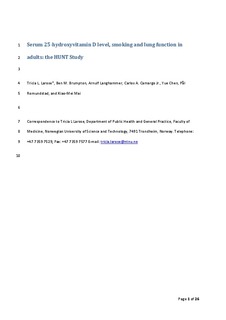| dc.contributor.author | Larose, Tricia L | |
| dc.contributor.author | Brumpton, Ben Michael | |
| dc.contributor.author | Langhammer, Arnulf | |
| dc.contributor.author | Camargo, Carlos A | |
| dc.contributor.author | Chen, Yue | |
| dc.contributor.author | Romundstad, Pål Richard | |
| dc.contributor.author | Mai, Xiao-Mei | |
| dc.date.accessioned | 2017-06-12T10:40:05Z | |
| dc.date.available | 2017-06-12T10:40:05Z | |
| dc.date.created | 2015-06-25T14:15:32Z | |
| dc.date.issued | 2015 | |
| dc.identifier.citation | European Respiratory Journal. 2015, 46 (2), 355-363. | nb_NO |
| dc.identifier.issn | 0903-1936 | |
| dc.identifier.uri | http://hdl.handle.net/11250/2445773 | |
| dc.description.abstract | The association between serum 25-hydroxyvitamin D (25(OH)D) level and lung function changes in the general population remains unclear.
We conducted cross-sectional (n=1220) and follow-up (n=869) studies to investigate the interrelationship of serum 25(OH)D, smoking and lung function changes in a random sample of adults from the Nord-Trøndelag Health (HUNT) Study, Norway.
Lung function was measured using spirometry and included forced expiratory volume in 1 s (FEV1) % predicted, forced vital capacity (FVC) % pred and FEV1/FVC ratio. Multiple linear and logistic regression models estimated the adjusted difference in lung function measures or lung function decline, adjusted odds ratios for impaired lung function or development of impaired lung function and 95% confidence intervals.
40% of adults had serum 25(OH)D levels <50 nmol·L−1. Overall, those with a serum 25(OH)D level <50 nmol·L−1 showed worse lung function and increased odds of impaired lung function compared to the ≥50 nmol·L−1 group. These associations tended to be stronger among ever-smokers, including greater decline in FEV1/FVC ratio and greater odds of the development of impaired lung function (FEV1/FVC <70% OR 2.4, 95% CI 1.2–4.9). Associations among never-smokers were null. Results from cross-sectional and follow-up studies were consistent. There were no associations between serum 25(OH)D levels and lung function or lung function changes in never-smokers, whereas significant associations were observed in ever-smokers. | nb_NO |
| dc.language.iso | eng | nb_NO |
| dc.publisher | European Respiratory Society | nb_NO |
| dc.title | Serum 25-hydroxyvitamin D level, smoking and lung function in adults: the HUNT Study | nb_NO |
| dc.type | Journal article | nb_NO |
| dc.type | Peer reviewed | nb_NO |
| dc.description.version | acceptedVersion | nb_NO |
| dc.source.pagenumber | 355-363 | nb_NO |
| dc.source.volume | 46 | nb_NO |
| dc.source.journal | European Respiratory Journal | nb_NO |
| dc.source.issue | 2 | nb_NO |
| dc.identifier.doi | 10.1183/09031936.00226614 | |
| dc.identifier.cristin | 1250751 | |
| dc.relation.project | Norges forskningsråd: 201895 | nb_NO |
| dc.description.localcode | This is an author-submitted, peer-reviewed version of a manuscript that has been accepted for publication in the European Respiratory Journal, prior to copy-editing, formatting and typesetting. This version of the manuscript may not be duplicated or reproduced without prior permission from the copyright owner, the European Respiratory Society. The publisher is not responsible or liable for any errors or omissions in this version of the manuscript or in any version derived from it by any other parties. The final, copy-edited, published article, which is the version of record, is available without a subscription 18 months after the date of issue publication | nb_NO |
| cristin.unitcode | 194,65,20,0 | |
| cristin.unitname | Institutt for samfunnsmedisin | |
| cristin.ispublished | true | |
| cristin.fulltext | postprint | |
| cristin.qualitycode | 2 | |
